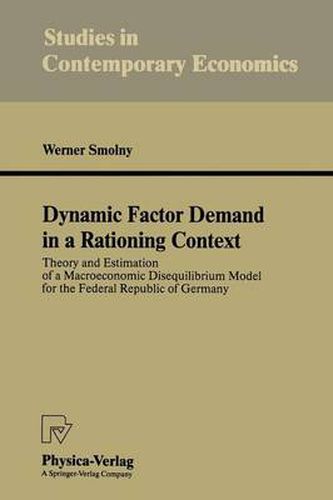Readings Newsletter
Become a Readings Member to make your shopping experience even easier.
Sign in or sign up for free!
You’re not far away from qualifying for FREE standard shipping within Australia
You’ve qualified for FREE standard shipping within Australia
The cart is loading…






This title is printed to order. This book may have been self-published. If so, we cannot guarantee the quality of the content. In the main most books will have gone through the editing process however some may not. We therefore suggest that you be aware of this before ordering this book. If in doubt check either the author or publisher’s details as we are unable to accept any returns unless they are faulty. Please contact us if you have any questions.
A macroeconomic disequilibrium model is developed for the Federal Republic of Germany. Starting with a microeconomic model of a firm’s behaviour, the optimal dynamic adjustment of employment and investment is derived. The model of the firm is complemented by an explicit aggregation procedure from which it derives macroeconomic relations. The model is estimated with macroeconomic data for the Federal Republic of Germany. An important feature is the consistent introduction of dynamic adjustment into a model of the firm. A new method is the particular approach of a delayed adjustment of employment and investment. The estimation results show significant underutilizations of labour and capital, and indicate the importance of supply constraints for imports and exports. As the most prominent result, they reveal the importance of the slow adjustment of employment and investment for the macroeconomic situation in Germany, especially for the persistence of high unemployment in the 1980s.
$9.00 standard shipping within Australia
FREE standard shipping within Australia for orders over $100.00
Express & International shipping calculated at checkout
This title is printed to order. This book may have been self-published. If so, we cannot guarantee the quality of the content. In the main most books will have gone through the editing process however some may not. We therefore suggest that you be aware of this before ordering this book. If in doubt check either the author or publisher’s details as we are unable to accept any returns unless they are faulty. Please contact us if you have any questions.
A macroeconomic disequilibrium model is developed for the Federal Republic of Germany. Starting with a microeconomic model of a firm’s behaviour, the optimal dynamic adjustment of employment and investment is derived. The model of the firm is complemented by an explicit aggregation procedure from which it derives macroeconomic relations. The model is estimated with macroeconomic data for the Federal Republic of Germany. An important feature is the consistent introduction of dynamic adjustment into a model of the firm. A new method is the particular approach of a delayed adjustment of employment and investment. The estimation results show significant underutilizations of labour and capital, and indicate the importance of supply constraints for imports and exports. As the most prominent result, they reveal the importance of the slow adjustment of employment and investment for the macroeconomic situation in Germany, especially for the persistence of high unemployment in the 1980s.